|
|
|
Sort Order |
|
|
|
Items / Page
|
|
|
|
|
|
|
| Srl | Item |
| 1 |
ID:
093604
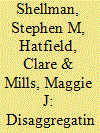

|
|
|
|
|
| Publication |
2010.
|
| Summary/Abstract |
While some of the intrastate war literature calls for the disaggregation of civil conflict, most of those studies focus on the geography of civil conflict failing to take into account the various actors involved in such conflicts. This study addresses the multi-actor nature of civil conflict by examining whether 'actor aggregation' affects the inferences drawn from quantitative studies of civil conflict. Using two cases, Cambodia (1980-2004) and Indonesia (1980-2004), the authors examine how multiple dissident groups' behavior aggregated together can affect the inferences drawn from quantitative studies of government-dissident interactions. The results demonstrate that researchers may draw different inferences and commit both Type I and Type II errors using different actor aggregations. The results have myriad implications for the study of civil conflict and conflict processes.
|
|
|
|
|
|
|
|
|
|
|
|
|
|
|
|
| 2 |
ID:
163327
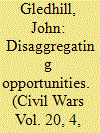

|
|
|
|
|
| Summary/Abstract |
In studies of armed conflict and civil war, it is common to distinguish between explanations that focus on the motives of insurgents and accounts that examine opportunities for rebellion. But what do scholars actually mean by ‘opportunities’? Some invoke the concept when referring to contexts in which states cannot suppress rebellion. For others, opportunities exist where insurgents have access to resources that facilitate the realisation of collective violence. And a third group refers to opportunities when discussing both of the above contexts. Across the field, then, the concept is used inconsistently. Consequently, I propose two conceptual clarifications. Drawing on insights from sociological literature, I argue that ‘opportunities’ should be disaggregated into two, more finite concepts: opportunity structures, understood as arrangements that inform externally imposed constraints on insurgency; and organisational resources, understood as means that shape the internal capacity of armed groups. Second, I suggest that conflict scholars should consider both material/institutional and social/normative dimensions of each disaggregated concept. To illustrate the heuristic benefits of the proposed framework, I use it as a basis for exploring variation in collective violence in Albania during the 1990s. That variation appears puzzling when seen through aggregated lenses but is explicable when examined through disaggregated lenses.
|
|
|
|
|
|
|
|
|
|
|
|
|
|
|
|
| 3 |
ID:
167292
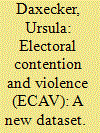

|
|
|
|
|
| Summary/Abstract |
Recent elections in Afghanistan, Bangladesh, Côte d’Ivoire, Egypt, Iraq, Kenya, Nigeria, and Pakistan have displayed substantial contestation and violence. A growing literature explores the causes and consequences of electoral contention and violence, but researchers lack comprehensive, disaggregated data establishing a substantive link between elections and violence. The Electoral Contention and Violence (ECAV) dataset conceptualizes electoral contention as nonviolent or violent events of contestation by state or non-state actors related to national elections. The data contain more than 18,000 events of election-related contention covering 136 countries holding competitive national elections between 1990 and 2012. This article describes the scope of ECAV, presents the project’s definition of electoral contention and the variables included, and outlines the coding procedure. We then compare ECAV to other datasets on electoral contention. Cross-national and subnational analyses of electoral competition and violence show that the data are useful for assessing the global and subnational implications of existing theories. ECAV addresses current data limitations by focusing on election-related contention, by using clear criteria to determine whether events are election-related, and by identifying the timing, geocoded location, and actors involved.
|
|
|
|
|
|
|
|
|
|
|
|
|
|
|
|
| 4 |
ID:
160473
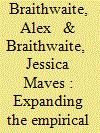

|
|
|
|
|
| Summary/Abstract |
This article introduces a special issue of Journal of Global Security Studies on advances in the disaggregated study of actors and tactics in nonviolent civil resistance campaigns. We initially discuss the recent rise of empirical, primarily quantitative research on nonviolence and civil resistance. We then note that the latest innovations in this literature are providing a disaggregated perspective on the actors engaging in nonviolence, as well as the tactics that they employ in doing so. In many respects, this direction parallels that taken in the study of civil wars over the past two decades. At the heart of this evolution in the research agenda on nonviolence is the availability of new, more nuanced data. The five articles in this issue very neatly demonstrate best practices in asking compelling research questions, deriving nontrivial hypotheses, and providing new data on the disaggregated nature of campaigns of nonviolent resistance.
|
|
|
|
|
|
|
|
|
|
|
|
|
|
|
|
| 5 |
ID:
090993


|
|
|
|
|
| Publication |
2009.
|
| Summary/Abstract |
Why do some armed civil conflicts last longer than others? Drawing on a contest success function model, we show that geographic factors (such as location, terrain, and natural resources) interact with rebel fighting capacity and together play a crucial role in determining the duration of conflict. Using precisely dated duration data in event history models and geographic data for the conflict location, we find that conflicts located at considerable distance from the main government stronghold, along remote international borders and in regions with valuable minerals last substantially longer. In addition, we find that rebel military capacity in its own right increases the prospects of a civil conflict ending within a short time period. Our findings imply that the distances an army must travel to project power, rebel fighting capacity, and characteristics of conflict region affect how a civil war is fought and who will prevail.
|
|
|
|
|
|
|
|
|
|
|
|
|
|
|
|
| 6 |
ID:
090998
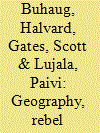

|
|
|
|
|
| Publication |
2009.
|
| Summary/Abstract |
Why do some armed civil conflicts last longer than others? Drawing on a contest success function model, we show that geographic factors (such as location, terrain, and natural resources) interact with rebel fighting capacity and together play a crucial role in determining the duration of conflict. Using precisely dated duration data in event history models and geographic data for the conflict location, we find that conflicts located at considerable distance from the main government stronghold, along remote international borders and in regions with valuable minerals last substantially longer. In addition, we find that rebel military capacity in its own right increases the prospects of a civil conflict ending within a short time period. Our findings imply that the distances an army must travel to project power, rebel fighting capacity, and characteristics of conflict region affect how a civil war is fought and who will prevail
|
|
|
|
|
|
|
|
|
|
|
|
|
|
|
|
| 7 |
ID:
122903
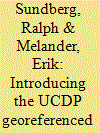

|
|
|
|
|
| Publication |
2013.
|
| Summary/Abstract |
This article presents the UCDP Georeferenced Event Dataset (UCDP GED). The UCDP GED is an event dataset that disaggregates three types of organized violence (state-based conflict, non-state conflict, and one-sided violence) both spatially and temporally. Each event - defined as an instance of organized violence with at least one fatality - comes with date, geographical location, and identifiers that allow the dataset to be linked to and merged with other UCDP datasets. The first version of the dataset covers events of fatal violence on the African continent between 1989 and 2010. This article, firstly, introduces the rationale for the new dataset, and explains the basic coding procedures as well as the quality controls. Secondly, we discuss some of the data's potential weaknesses in representing the universe of organized violence, as well as some potential biases induced by the operationalizations. Thirdly, we provide an example of how the data can be used, by illustrating the association between cities and organized violence, taking population density into account. The UCDP GED is a useful resource for conflict analyses below the state and country-year levels, and can provide us with new insights into the geographical determinants and temporal sequencing of warfare and violence.
|
|
|
|
|
|
|
|
|
|
|
|
|
|
|
|
| 8 |
ID:
167285
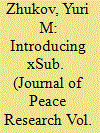

|
|
|
|
|
| Summary/Abstract |
Researchers today have access to an unprecedented amount of geo-referenced, disaggregated data on political conflict. Because these new data sources use disparate event typologies and units of analysis, findings are rarely comparable across studies. As a result, we are unable to answer basic questions like ‘what does conflict A tell us about conflict B?’ This article introduces xSub – a ‘database of databases’ for disaggregated research on political conflict (www.x-sub.org). xSub reduces barriers to comparative subnational research, by empowering researchers to quickly construct custom, analysis-ready datasets. xSub currently features subnational data on conflict in 156 countries, from 21 sources, including large data collections and data from individual scholars. To facilitate comparisons across countries and sources, xSub organizes these data into consistent event categories, actors, spatial units (country, province, district, grid cell, electoral constituency), and time units (year, month, week, and day). This article introduces xSub and illustrates its potential, by investigating the impact of repression on dissent across thousands of subnational datasets.
|
|
|
|
|
|
|
|
|
|
|
|
|
|
|
|
| 9 |
ID:
090987
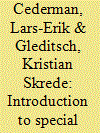

|
|
|
|
|
| Publication |
2009.
|
| Summary/Abstract |
We introduce the contributions to this special issue on "Disaggregating Civil War." We review the problems arising from excessive aggregation in studies of civil war, and outline how disaggregation promises to provide better insights into the causes and dynamics of civil wars, using the articles in this special issue as examples. We comment on the issue of the appropriate level of disaggregation, lessons learned from these articles, and issues for further research.
We introduce the contributions to this special issue on "Disaggregating Civil War." We review the problems arising from excessive aggregation in studies of civil war, and outline how disaggregation promises to provide better insights into the causes
|
|
|
|
|
|
|
|
|
|
|
|
|
|
|
|
| 10 |
ID:
117239
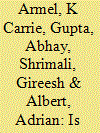

|
|
|
|
|
| Publication |
2013.
|
| Summary/Abstract |
This paper aims to address two timely energy problems. First, significant low-cost energy reductions can be made in the residential and commercial sectors, but these savings have not been achievable to date. Second, billions of dollars are being spent to install smart meters, yet the energy saving and financial benefits of this infrastructure - without careful consideration of the human element - will not reach its full potential. We believe that we can address these problems by strategically marrying them, using disaggregation. Disaggregation refers to a set of statistical approaches for extracting end-use and/or appliance level data from an aggregate, or whole-building, energy signal. In this paper, we explain how appliance level data affords numerous benefits, and why using the algorithms in conjunction with smart meters is the most cost-effective and scalable solution for getting this data. We review disaggregation algorithms and their requirements, and evaluate the extent to which smart meters can meet those requirements. Research, technology, and policy recommendations are also outlined.
|
|
|
|
|
|
|
|
|
|
|
|
|
|
|
|
| 11 |
ID:
113941
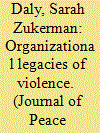

|
|
|
|
|
| Publication |
2012.
|
| Summary/Abstract |
Why do insurgencies erupt in some places and not in others? This article exploits an original violent event database of 274,428 municipality-month observations in Colombia to determine the conditions favoring organized violence at the subnational level. The data cast doubt on the conventional correlates of war: poverty, rough terrain, lootable natural resources, and large, sparsely distributed populations. The evidence suggests that rebellions begin not in localities that afford sanctuaries, impoverished recruits, and abundant finances, but instead in regions providing receptacles of collective action: the organizational legacies of war. Specifically, the data indicate that regions affected by past mobilization are six times more likely to experience rebellion than those without a tradition of armed organized action. The significant correlation between prior and future mobilization is robust across different measurements of the concepts, levels of aggregations of the data, units of analysis, and specifications of the model. These include rare events and spatial lag analyses. These results highlight the need for micro conflict data, theory disentangling the causes of war onset from those of war recurrence, and a reorientation away from physical geography and back to the human and social geography that determines if rebellion is organizationally feasible. The findings suggest new avenues of research on the post-war trajectories of armed organizations, the causes of repeated war, and the micro-foundations of rebellion.
|
|
|
|
|
|
|
|
|
|
|
|
|
|
|
|
| 12 |
ID:
112782
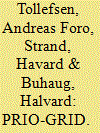

|
|
|
|
|
| Publication |
2012.
|
| Summary/Abstract |
Contributions to the quantitative civil war literature increasingly rely on geo-referenced data and disaggregated research designs. While this is a welcome trend, it necessitates geographic information systems (GIS) skills and imposes new challenges for data collection and analysis. So far, solutions to these challenges differ between studies, obstructing direct comparison of findings and hampering replication and extension of earlier work. This article presents a standardized structure for storing, manipulating, and analyzing high-resolution spatial data. PRIO-GRID is a vector grid network with a resolution of 0.5 x 0.5 decimal degrees, covering all terrestrial areas of the world. Gridded data comprise inherently apolitical entities; the grid cells are fixed in time and space, they are insensitive to political boundaries and developments, and they are completely exogenous to likely features of interest, such as civil war outbreak, ethnic settlement patterns, extreme weather events, or the spatial distribution of wealth. Moreover, unlike other disaggregated approaches, gridded data may be scaled up or down in a consistent manner by varying the resolution of the grid. The released dataset comes with cell-specific information on a large selection of political, economic, demographic, environmental, and conflict variables for all years, 1946-2008. A simple descriptive data assessment of population density and economic activity is offered to demonstrate how PRIO-GRID may be applied in quantitative social science research.
|
|
|
|
|
|
|
|
|
|
|
|
|
|
|
|
| 13 |
ID:
170811
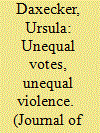

|
|
|
|
|
| Summary/Abstract |
Elections held outside of advanced, industrialized democracies can turn violent because elites use coercion to demobilize political opponents. The literature has established that closely contested elections are associated with more violence. I depart from this emphasis on competitiveness by highlighting how institutional biases in electoral systems, in particular uneven apportionment, affect incentives for violence. Malapportionment refers to a discrepancy between the share of legislative seats and the share of population, violating the ‘one person, one vote’ principle. Drawing on recent work on malapportionment establishing that overrepresented districts are targeted with clientelist strategies, are more homogenous, and are biased in favor of district-level incumbent parties, I argue that overrepresented districts present fewer incentives for using violence. In contrast, elites in well-apportioned or underrepresented districts exert less control over electoral outcomes because such districts have more heterogenous voter preferences, raising incumbent and opposition demands to employ violence. I examine the effects of malapportionment on violence using constituency-level elections data and new, disaggregated, and geocoded event data on the incidence of election violence in India. Results from six parliamentary elections from 1991 to 2009 show that electoral violence is less prevalent in overrepresented constituencies, and that violence increases in equally apportioned and moderately underrepresented districts. The analysis establishes additional observable implications of the argument for district voter homogeneity and incumbent victory, accounts for confounders such as urbanization and state-level partisanship, and validates measures of election violence. The findings illustrate that institutional biases shape incentives for electoral violence.
|
|
|
|
|
|
|
|
|
|
|
|
|
|
|
|
| 14 |
ID:
175742
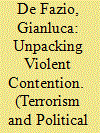

|
|
|
|
|
| Summary/Abstract |
This paper systematically describes the different types of political violence that occurred in Northern Ireland between 1968 and 1972, examining how they interacted and fueled each other. To measure the level of political violence in Northern Ireland, traditional quantitative approaches use variables such as the number of conflict-related deaths, paramilitary attacks, or riots; the goal of this paper, instead, is to disaggregate acts of violent contention by actor, type, and target. Relying on Quantitative Narrative Analysis (QNA), all the violent actions perpetrated by the actors participating in the conflict have been recorded, coded, and analyzed. Three main types of violence in Northern Ireland are identified: a) protest-related violence—violent interactions among protesters, counterprotesters, and police before, during, and after mass demonstrations; b) sectarian violence—includes riots and clashes between members of the two main ethno-national communities; and c) armed conflict—violent actions by paramilitary groups and security forces. While originating from different conflict situations, these three types of violence affected each other, as they altered, and were altered by, the broader political context. Conceptual and methodological disaggregation of political violence are encouraged to better understand violent conflicts.
|
|
|
|
|
|
|
|
|
|
|
|
|
|
|
|
|
|
|
|
|